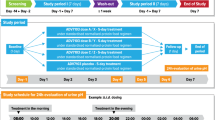Abstract
In 12 healthy volunteers the pharmacokinetic parameters of two new sustained-release formulations of disodiummonofluorophosphate (MFP) (B and C) were compared with those of a nonsustained-release reference preparation (A). This randomized study had a single-dose, triple-cross over design and consisted of 3 trial days separated by a 1-week washout period. Serial blood samples were obtained over a period of 24 hours and 24-hour urine was collected. Serum and urine fluoride concentrations were determined using an ion-sensitive electrode (Orion Research). The results of this study showed a significant reduction of the area under the serum concentration versus time curve (AUC) for the sustained-release formulations (AUC B: 1487±354 ng/mlxhour, AUC C: 1369±384 ng/mlxhour) compared with the reference preparation (AUC A: 2374±652 ng/mlxhour) (B/A: 63%, C/A: 58%) (P<0.001). Furthermore, the peak serum concentrations of fluoride (Cmax) for B and C (CmaxB: 166±42 ng/ml, CmaxC: 110±48 ng/ml) were significantly lower than for A (CmaxA: 380±77 ng/ml) (P<0.001). The 24-hour urine fluoride recovery rates were 5.6±0.7 mg fluoride for A, 3.6±0.8 mg for B, and 3.2±1.1 mg for C and corresponded well to the relative fluoride bioavailability, as concluded from the serum fluoride concentration. In conclusion, the sustained-release preparations of MFP led to a decrease of fluoride bioavailability and avoided high peak serum concentrations.
Similar content being viewed by others
References
Jowsey J, Riggs BL, Kelly PJ, Hoffman DL (1972) Effect of combined therapy with sodium fluoride, vitamin D and calcium in osteoporosis. Am J Med 53:43–49
Farley JR, Wergedal JE, Baylink DJ (1983) Fluoride directly stimulates proliferation and alkaline phosphatase activity of bone-forming cells. Science 222:330–332
Pak CYC, Sakhaee K, Zerwekh JE, Parcel C, Peterson R, Johnson K (1989) Safe and effective treatment of osteoporosis with intermittent slow release sodium fluoride: augmentation of vertebral bone mass and inhibition of fractures. J Clin Endocrinol Metab 68(1):150–159
Kraenzlin ME, Kraenzlin C, Farley SMG, Fitzsimmons RJ, Baylink DJ (1990) Fluoride pharmacokinetics in good and poor responders to fluoride therapy. J Bone Miner Res 5(suppl 1): 49–52
Delmas PD, Dupuis J, Duboeuf F, Chapuy MC, Meunier PJ (1990) Treatment of vertebral osteoporosis with disodium monofluorophosphate: comparison with sodium fluoride. J Bone Miner Res 5(suppl 1):143–147
Mamelle N, Dusan R, Martin JL, Prost A, Meunier PJ, Guillaume M, Gaucher A, Zeigler G (1988) Risk-benefit ratio of sodium fluoride treatment in primary vertebral osteoporosis. Lancet 2:361–365
Nagant de Deuxchaisnes C, Devogelaer JP, Depressuex G, Malghem J, Maldague B (1990) Treatment of the vertebral crush fracture syndrome with enteric-coated sodium fluoride tablets and calcium supplements. J Bone Miner Res 5(suppl 1):5–26
Riggs BL, Hodgson SF, O'Fallon WM, Chao EYS, Wahner HW, Muhs JM, Cedel SL, Melton III LJ III (1990) Effects of fluoride treatment on the fracture rate in postmenopausal women with osteoporosis. N Engl J Med 322:802–809
Sakhaee K, Pak CYC (1991) Fluoride bioavailability from immediate-release sodium fluoride with calcium carbonate compared with slow-release sodium fluoride with calcium citrate. Bone Miner 14:131–136
Liote' F, Bardin C, Liou A, Brouard A, Terrier JL, Kuntz D (1992) Bioavailability of fluoride in postmenopausal women: comparative study between sodium fluoride and disodium monofluorophosphate-calcium carbonate. Calcif Tissue Int 50: 209–213
Taves DR (1970) New approach to the treatment of bone disease with fluoride. Fed Proc 29(3):1185–1187
Trautner K (1989) Influence of food on bioavailability of fluoride in man from Na2FPO3-containing tablets for the treatment of osteoporosis. Int J Clin Pharmacol Ther Toxicol 27(5):242–249
Farley JR, Tarbaux NM, Lau KHW, Baylink DJ (1987) Monofluorophosphate is hydrolyzed by alkaline phosphatase and mimics the actions of NaF on skeletal tissues, in vitro. Calcif Tissue Int 40:35–42
Resch H, Libanati C, Talbot J, Tabuenca M, Farley S, Bettica P, Tritthart W, Baylink D (1994) Pharmacokinetic profile of a new fluoride preparation: sustained-release monofluorophosphate. Calcif Tissue Int 54:7–11
Turner CH, Boivin G, Meunier PJ (1993) A mathematical model for fluoride uptake by the skeleton. Calcif Tissue Int 52:130–138
Author information
Authors and Affiliations
Rights and permissions
About this article
Cite this article
Erlacher, L., Templ, H. & Magometschnigg, D. A comparative bioavailability study on two new sustained-release formulations of disodiummonofluorophosphate versus a nonsustained-release formulation in healthy volunteers. Calcif Tissue Int 56, 196–200 (1995). https://doi.org/10.1007/BF00298609
Received:
Accepted:
Issue Date:
DOI: https://doi.org/10.1007/BF00298609




